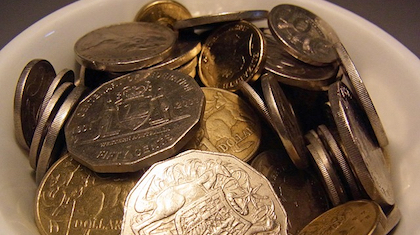Incredibly, Australians are now literally throwing away coins rather than using or saving them. This article highlights this issue and recommends some ideas to reduce wasting money; whether it is as coins or other expensive habits. It provides a simple example of how much a small amount can grow into a substantial figure.

While the move is on to become a cashless society, notes and coins are likely to be with us for some time yet. ‘Touch and go’ payments may be increasing, but for many small purchases most of us still rely on good old cash. And because it’s easier to hand over a note for each purchase than to scramble in our pockets or purses for the correct change, by the end of the week we often end up with a hefty pile of low value coins. These coins are such a pain that, according to one survey, 93% of respondents admitted to throwing away five cent pieces, with 29% even ditching ten cent pieces.
Okay, so tossing away a dollar’s worth of small change each week won’t put much of a dent in your future wealth, but at least consider dropping those coins into a donation box. Combined with thousands of other peoples’ donations your spare change can make a real difference to the services that charities provide.
There are, however, other areas where we effectively throw away money, and in amounts that can really add up:
-
Food: on average Australians throw away around one third of the food we buy.
-
Gas and electricity: when was the last time you shopped around for the best deal on your gas and power bills? You could save hundreds of dollars a year.
-
Gift cards: often end up at the back of a drawer until they expire, or you may only spend part of the total value.
-
Impulse buying: how much do you spend on clothing you don’t wear and stuff you don’t use?
-
Lunches: even if you skip the smashed avo, a takeaway lunch costs much more than one you make yourself.
In most of these cases the solutions are pretty obvious.
-
Only buy the food you will use. A few loose carrots and apples might be a better buy than the kilo bags that start to rot in the crisper. If you regularly have a surplus of some foods find recipes that use them. Soups and casseroles are a great way to use up all sorts of ingredients.
-
Compare what other gas and electricity retailers are offering.
-
Have a good look at your credit card statement. Were all your purchases necessary?
-
Place your gift cards in front of your credit cards to remind you to use them instead.
-
Make your own lunch. Many people can easily save $10 or $15 dollars per day with very little effort. Once any impulse buying habits are under control, this could be the supercharger of your savings.
Will implementing these changes make a real difference? Let’s see.
Imagine that you adopt some of these suggestions and as a result save an average of $60 per week. Stashed away in a savings account earning an interest rate of 2% per annum for 20 years, those modest weekly savings will grow to over $76,700. Contributed to an investment that provides an average return of 7% pa and you could be looking at having around $136,000 in 20 years’ time.
Does that give you a better idea of how much money you could really be throwing away?
What to do with your newfound savings capacity will depend on your goals and situation.
Your financial adviser will be able to help you make the most of the money you don’t throw away.
Please contact us on 1300 874 474
Important
Any information provided by the author detailed above is separate and external to our business and our Licensee. Neither our business, nor our Licensee take any responsibility for any action or any service provided by the author.
Any links have been provided with permission for information purposes only and will take you to external websites, which are not connected to our company in any way. Note: Our company does not endorse and is not responsible for the accuracy of the contents/information contained within the linked site(s) accessible from this page.
